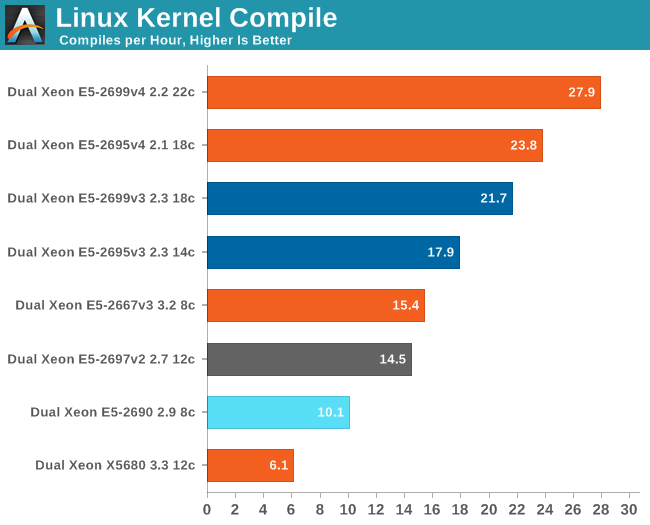The Intel Xeon E5 v4 Review: Testing Broadwell-EP With Demanding Server Workloads
by Johan De Gelas on March 31, 2016 12:30 PM EST- Posted in
- CPUs
- Intel
- Xeon
- Enterprise
- Enterprise CPUs
- Broadwell
Application Development: Linux Kernel Compile
A more real world benchmark to test the integer processing power of our Xeon servers is a Linux kernel compile. Although few people compile their own kernel, compiling other software on servers is a common task and this will give us a good idea of how the CPUs handle a complex build.
To do this we have downloaded the 3.11 kernel from kernel.org. We then compiled the kernel with the "time make -jx" command, where x is the maximum number of threads that the platform is capable of using. To make the graph more readable, the number of seconds in wall time was converted into the number of builds per hour.

A kernel compile does not scale perfectly with more cores, but the Xeon E5-2699 v4 offers up to 2.7 times better performance than the Xeon it is supposed to replace. This kind of workload really seems to favor the new Broadwell core: even at slightly lower clockspeeds, the 18 core Xeon E5-2695 v4 beats the v3 version with the same number of cores by 9%.










112 Comments
View All Comments
patrickjp93 - Friday, April 1, 2016 - link
Knight's Landing: 730 mm^2, also on the 14nm platformextide - Friday, April 1, 2016 - link
Is it really that big..? Wow, I knew it was big, but didn't know it was that big. Got a source on that?Kevin G - Friday, April 8, 2016 - link
I'll second a link for a source. I knew it'd be big but that big?extide - Friday, April 1, 2016 - link
I know you meant Reticle, but that was a pretty funny typo, heh.Kevin G - Friday, April 8, 2016 - link
Autocorrect has gotten the best of me yet again.extide - Friday, April 1, 2016 - link
And, I know how big GM200 and Fiji are, but I am talking about big GPU's on 14/16nm. All signs are currently pointing to <300mm^2 for the first round of 14/16nm GPU's.lorribot - Thursday, March 31, 2016 - link
Given the way Microsoft and others are now licensing by the core and in large non splitable packages (Windows 2016 Datacenter is in blocks of 16 cores, a dual socket server with 44 cores would need 48 core licences) the increasing core count has limited appeal over small numbers of faster cores when looking at virtualised environments.Those still in the physical world will still have to pay per core but may have to buy 4 std Windows licenses.
when it comes to doing your testing, it should reflect these costs and compare total bang per buck when dealing with performance.
Red Hat still licences per socket but don't be surprised if they go per core too.
JohanAnandtech - Friday, April 1, 2016 - link
Back in 2008, I had a sales person explaining the license models of Microsoft to me in our lab. From that point on, we have invested most of our time and resources in linux server software. :-Dextide - Friday, April 1, 2016 - link
Enterprise linux isn't free, either ya knowrahvin - Friday, April 1, 2016 - link
Support isn't free on the FOSS side but the software is. Redhat is never going to charge more per "cores" for support, that's ridiculous and would result in rivals stealing their support contracts. If licensing costs are that bad that you are dumping hardware you really should be looking at moving services to Linux and Visualizing the windows servers so you can limit the core count and provide more horsepower.Anyone putting Microsoft on bare hardware these days is nuts. Although the consolation is that they get to pay MS's exorbitant tax on software. Linux should be the core component of any IT services and virtualized servers where you need proprietary server software.